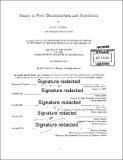| dc.contributor.advisor | Glenn Ellison, Nancy Rose and Paulo Somaini. | en_US |
| dc.contributor.author | Moshary, Sarah N. S. (Sarah Nazpai Schwartz) | en_US |
| dc.contributor.author | Illanes, Gaston | en_US |
| dc.contributor.other | Massachusetts Institute of Technology. Department of Economics. | en_US |
| dc.date.accessioned | 2016-03-03T21:06:09Z | |
| dc.date.available | 2016-03-03T21:06:09Z | |
| dc.date.copyright | 2015 | en_US |
| dc.date.issued | 2015 | en_US |
| dc.identifier.uri | http://hdl.handle.net/1721.1/101516 | |
| dc.description | Thesis: Ph. D., Massachusetts Institute of Technology, Department of Economics, 2015. | en_US |
| dc.description | Cataloged from PDF version of thesis. "Chapter 3, co-authored with Gaston Illanes"--Page 2. | en_US |
| dc.description | Includes bibliographical references (pages 123-126). | en_US |
| dc.description.abstract | Chapter 1 studies price discrimination in advertising sales to Political Action Committees (PACs) in the 2012 Presidential Election. These groups have grown rapidly - expenditures neared $500 million in the 2012 presidential election - and their effect on elections depends on regulation and its interaction with imperfect competition. While the government tightly proscribes station behavior vis-a-vis official campaigns, it does not protect Political Actions Committees (PACs). Television stations potentially wield considerable power to shape access to the electorate. Using novel data on prices paid for individual ad spots from the 2012 presidential election, I find PACs pay a 40% markup above campaign rates, and that there are differences in prices paid by Republican and Democratic groups for indistinguishable purchases. I then develop and estimate a model of political demand for ad spots, exploiting misalignments of state borders and media markets to address potential price endogeneity. Findings indicate that pricing to PACs reflects buyer willingness-to-pay for viewer demographics. Chapter 2 investigates spillover effects of regulation protecting campaign advertising purchases, a most favored nation clause. This regulation guarantees campaigns the lowest rate received by any advertiser, incentivizing stations to sell less airtime to commercial advertisers to buoy campaign prices. Using spot-level data on presidential campaign advertising purchases from 2012, I find that campaign ad prices drop following the institution of rate regulation (sixty days preceding election day). I then develop a model of station price discrimination, and estimate the effect of regulation on campaign and commercial prices relative to a counterfactual without regulation. Chapter 3, co-authored with Gaston Illanes, studies the effects of potential entry on market outcomes in the context of Washington state's 2012 privatization of liquor sales. Theory indicates that entry, and even the threat of entry, plays a key role in discipling market outcomes. We exploit the post-reform licensure requirement that stores have 10,000 square feet of retail space to estimate the impact of an additional store on price competition. We compare prices and product variety in markets with stores just above versus just below the square footage cutoff. | en_US |
| dc.description.statementofresponsibility | by Sarah N. S. Moshary. | en_US |
| dc.format.extent | 126 pages | en_US |
| dc.language.iso | eng | en_US |
| dc.publisher | Massachusetts Institute of Technology | en_US |
| dc.rights | M.I.T. theses are protected by copyright. They may be viewed from this source for any purpose, but reproduction or distribution in any format is prohibited without written permission. See provided URL for inquiries about permission. | en_US |
| dc.rights.uri | http://dspace.mit.edu/handle/1721.1/7582 | en_US |
| dc.subject | Economics. | en_US |
| dc.title | Essays in price discrimination and regulation | en_US |
| dc.type | Thesis | en_US |
| dc.description.degree | Ph. D. | en_US |
| dc.contributor.department | Massachusetts Institute of Technology. Department of Economics | |
| dc.identifier.oclc | 939917265 | en_US |
